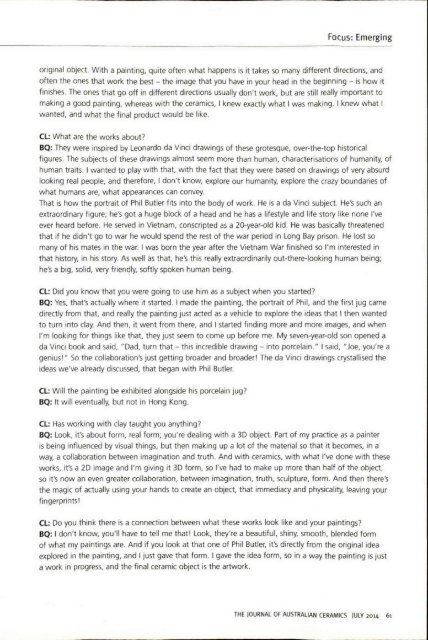The Journal of Australian Ceramics Vol 53 No 2 July 2014
Create successful ePaper yourself
Turn your PDF publications into a flip-book with our unique Google optimized e-Paper software.
Focus: Emerging<br />
original object. With a painting, quite <strong>of</strong>ten what happens is it takes so many different directions, and<br />
<strong>of</strong>ten the ones that work the best - the image that you have in your head in the beginning - is how it<br />
finishes. <strong>The</strong> ones that go <strong>of</strong>f in different directions usually don't work, but are still really important to<br />
making a good painting, whereas with the ceramics, I knew exactly what I was making. I knew what I<br />
wanted, and what the final product would be like.<br />
Cl: What are the works about?<br />
BQ: <strong>The</strong>y were inspired by Leonardo da Vinci drawings <strong>of</strong> these grotesque, over-the-top historical<br />
figures. <strong>The</strong> subjects <strong>of</strong> these drawings almost seem more than human, characterisations <strong>of</strong> humanity, <strong>of</strong><br />
human traits. I wanted to play with that, with the fact that they were based on drawings <strong>of</strong> very absurd<br />
looking real people, and therefore, I don't know, explore our humanity, explore the crazy boundaries <strong>of</strong><br />
what humans are, what appearances can convey.<br />
That is how the portrait <strong>of</strong> Phi l Butler fits into the body <strong>of</strong> work. He is a da Vinci subject. He 's such an<br />
extraordinary figure; he's got a huge block <strong>of</strong> a head and he has a lifestyle and life story like none I've<br />
ever heard before. He served in Vietnam, conscripted as a 20-year-old kid. He was basically threatened<br />
that if he didn't go to war he would spend the rest <strong>of</strong> the war period in Long Bay prison. He lost so<br />
many <strong>of</strong> his mates in the war. I was born the year after the Vietnam War finished so I'm interested in<br />
that history, in his story. As well as that, he's this really extraordinarily out-there-Iooking human being;<br />
he's a big, solid, very friendly, s<strong>of</strong>tly spoken human being.<br />
Cl: Did you know that you were going to use him as a subject when you started?<br />
BQ: Yes, that's actually where it started. I made the painting, the portrait <strong>of</strong> Phil, and the first jug came<br />
directly from that, and really the painting just acted as a vehicle to explore the ideas that I then wanted<br />
to turn into clay. And then, it went from there, and I started finding more and more images, and when<br />
I'm looking for things like that, they just seem to come up before me. My seven-year-old son opened a<br />
da Vinci book and said, " Dad, turn that - this incredible drawing - into porcelain ." I said, "Joe, you're a<br />
genius!" So the collaboration's just getting broader and broader! <strong>The</strong> da Vinci drawings crystallised the<br />
ideas we've already discussed, that began with Phil Butler.<br />
Cl: Will the painting be exhibited alongside his porcelain jug7<br />
BQ: It will eventually, but not in Hong Kong.<br />
Cl: Has working with clay taught you anything?<br />
BQ: Look, it's about form, real form; you're dealing with a 3D object. Part <strong>of</strong> my practice as a painter<br />
is being influenced by visual things, but then making up a lot <strong>of</strong> the material so that it becomes, in a<br />
way, a collaboration between imagination and truth. And with ceramics, with what I've done with these<br />
works, it's a 2D image and I'm giving it 3D form, so I've had to make up more than half <strong>of</strong> the object,<br />
so it's now an even greater collaboration, between imagination, truth, sculpture, form. And then there's<br />
the magic <strong>of</strong> actually using your hands to create an object, that immediacy and physicality, leaving your<br />
fingerprints!<br />
Cl: Do you think there is a connection between what these works look like and your paintings?<br />
BQ: I don't know, you'll have to tell me that l Look, they're a beautiful, shiny, smooth, blended form<br />
<strong>of</strong> what my paintings are. And if you look at that one <strong>of</strong> Phil Butler, it's directly from the original idea<br />
explored in the painting, and I just gave that form. I gave the idea form, so in a way the painting is just<br />
a work in progress, and the final ceramic object is the artwork.<br />
THE JOURNAL OF AUSTRALIAN CERAMICS JULY <strong>2014</strong> 61

















